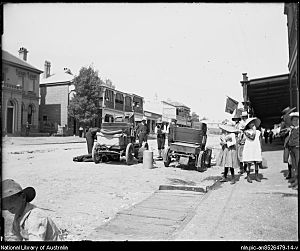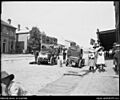Louis Gabriel facts for kids
Charles Louis Gabriel (born June 25, 1857 – died February 10, 1927) was an Australian doctor and a talented photographer. He was born in a small town called Kempsey in New South Wales. Like his father and grandfather, Louis became a physician. He studied medicine at the famous Edinburgh University in Scotland. There, he earned special qualifications in surgery and maternity care.
After his studies, he likely worked as a ship's doctor on his way back to Australia. He practiced medicine for a short time in Sydney. Then, in 1887, he moved to Gundagai. This was an inland town, about halfway between Sydney and Melbourne. Dr. Gabriel was very dedicated to his medical work. He only started photography as a hobby about twelve years later, around 1899. Over the next decade, he took more than 800 amazing photos using glass plates. These pictures are now kept at the National Library of Australia. They are a very important record of Australia, especially of Gundagai, which is a famous Australian town.
Contents
Who was Dr. Louis Gabriel?
His Family Background
Dr. Gabriel's family had roots in France, England, the West Indies, and Wales. He was often described as 'the black doctor' because of his dark skin. This was unusual in Australia at the time, especially as the country was developing its White Australia policy. His family had experienced the effects of slavery and being forced to move from their homes. People like the Gabriels, who were skilled black professionals, tried to gain acceptance through their hard work and good deeds. Living in the same place for a long time also helped them fit in.
Gundagai's Story
Louis Gabriel lived in Gundagai during a very important time. This was when the town became famous in Australian stories and poems. Gundagai started to be seen as a truly Australian place. It was known for being democratic, fair, tough, and practical. Dr. Gabriel's photos help us see what life was like during this period.
Dr. Gabriel's Medical Career
Dr. Gabriel worked in Gundagai from 1887 until he passed away in 1927. He became the main (and only) doctor at Gundagai Hospital in 1889. The hospital faced money problems during the 1890s depression. This led to some disagreements, and he was even fired for a while. It took him five years to get his job back after a tough time with another doctor, Dr. O'Dwyer. Dr. Gabriel kept his position at the hospital until his death.
Improving Public Health
From 1893, Dr. Gabriel also worked as the Government Medical Officer. This job greatly influenced him. He strongly believed in modern medicine, especially in community and public health. He pushed for better hygiene standards for food and water. He also wanted public and private places to be kept clean. He worked hard to prevent major diseases. He especially campaigned for new water systems and for a new Gundagai Hospital. This new hospital would be built using the latest medical ideas. It's also important to know that he insisted people of all races be treated equally at the hospital. This was at a time when Aboriginal people were often not allowed in towns.
Dr. Louis Gabriel was Catholic. His marriage to Jessie Walton in 1892 did not last very long.
His Legacy and Photographs
After Dr. Gabriel died, his photographs were put away and mostly forgotten until the 1950s. Since Gundagai was an important town in Australian history, his photos started to appear in local books about the town. In the 1970s, the images were given to the National Library of Australia. Gundagai also has a small museum dedicated to him.
In 1978, the National Library published a book called The Gundagai Album. This book brought new attention to Dr. Gabriel's photographs. Many people noticed his unique style. He had a special way of looking at and arranging people, time, and places in his pictures. His photos often felt personal and thoughtful. They also showed a strong sense of documenting real life, probably influenced by his medical training. He often used his own shadow and a wide-angle camera lens in his photos. This sometimes made his pictures feel both separate from the subjects and secretly involved.
After the book, several TV shows featured his work. He was also included in a special biography for Australia's Bicentennial. In 2007, a novel called Belonging was written by G. McDougall about Dr. Gabriel's life. This book even included his photographs within the story.
Images for kids



